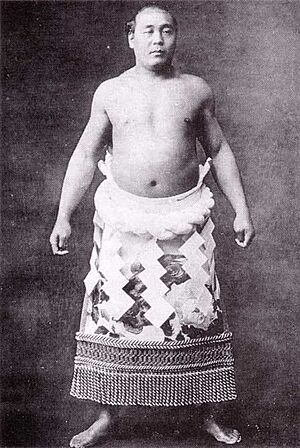Tachiyama Mineemon facts for kids
Quick facts for kids Tachiyama Mineemon |
|
|---|---|
| 太刀山 峯右衞門 | |

Tachiyama, circa 1916
|
|
| Personal information | |
| Born | Oimoto Yajirō August 15, 1877 Toyama, Japan |
| Died | March 4, 1941 (aged 63) |
| Height | 1.88 m (6 ft 2 in) |
| Weight | 150 kg (331 lb) |
| Career | |
| Stable | Tomozuna |
| Record | 211-30-73(11 draws) |
| Debut | May, 1900 |
| Highest rank | Yokozuna (February, 1911) |
| Retired | January, 1918 |
| Elder name | Azumazeki |
| Championships | 9 (Makuuchi, official) 2 (Makuuchi, unofficial) |
| * Up to date as of June 25, 2020. | |
Tachiyama Mineemon (born August 15, 1877 – died April 3, 1941) was a famous Japanese professional sumo wrestler. He came from Toyama City, Toyama Prefecture. He became the 22nd yokozuna, which is the highest rank in sumo. Tachiyama was known for his incredible strength and skill. He won an amazing 99 out of 100 matches between 1909 and 1916. He also won eleven top division tournaments. Two of these wins were before the official championship system started in 1909.
Tachiyama's Sumo Journey
Tachiyama's real name was Oimoto Yajirō. He joined a sumo training place called Tomozuna stable. Important people like Itagaki Taisuke and Saigō Tsugumichi encouraged him to join. At the stable, he trained with Kunimiyama, who later became an ōzeki (a high-ranking sumo wrestler). Tachiyama was so strong that most wrestlers found it hard to practice with him. So, another great wrestler, Hitachiyama Taniemon, became his special coach. Tachiyama was promoted to yokozuna in February 1911.
Tachiyama's Amazing Strength
Tachiyama was especially good at tsuki, which means pushing his opponents. In a tournament in June 1910, his powerful pushes made a wrestler named Kohitachi Yoshitaro fly over the spectators and land in the fourth row of seats! Kohitachi got hurt and had to leave the tournament. People also said that Tachiyama could lift a 400 kg (about 880 lb) shell with just one arm. Even though he was famous for pushing, he was also good at using the mawashi (the belt wrestlers grab).
Tachiyama was much taller and stronger than other wrestlers of his time. He never had a losing record in his eighteen-year career. A losing record is called make-koshi. While he was a yokozuna, he lost only three matches. He once won 43 matches in a row! Then he lost one match to Nishinoumi Kajirō II. After that, he won another 56 matches in a row! If he hadn't lost that one match, he would have won 100 matches in a row. He later said he lost that match on purpose to help his rival yokozuna. His second winning streak of 56 matches is the fifth best in sumo history.
His amazing winning streak ended in May 1916 when Tochigiyama Moriya finally beat him. Tachiyama won his last championship in that same tournament. He still holds the record for being the oldest yūshō (tournament winner) as of 2022. In January 1917, he lost to Ōnishiki Uichirō. Both Tochigiyama and Ōnishiki were students of Hitachiyama, Tachiyama's former coach. After this second loss, Tachiyama decided to retire from sumo.
Life After Sumo
In 1917, after he retired, Tachiyama challenged other wrestlers. He said he would give a bale of rice to anyone who could carry him around the dohyō (the sumo ring). A young boy, who had not yet started his professional sumo career, tried. He failed the first time but succeeded on his second try. About 15 years later, that boy became the yokozuna Tamanishiki San'emon.
Tachiyama's special yokozuna dohyō-iri (ring-entering ceremony) style became known as Shiranui. Later yokozuna like Haguroyama copied it. However, Tachiyama himself said his style was actually like Unryū Kyūkichi's.
Because he was so strong and big, people sometimes compared him to Raiden Tameemon, another legendary sumo wrestler. But his huge size also meant he might have been less popular with the public than other famous wrestlers like Hitachiyama and Umegatani II.
After retiring from wrestling, Tachiyama worked briefly as an elder in the Sumo Association under the name Azumazeki. But he left the sumo world in May 1919. In 1937, he was the first yokozuna to perform a kanreki dohyō-iri. This is a special '60th year ring entrance ceremony' that celebrates a former yokozuna's career.
See also
- Glossary of sumo terms
- Kanreki dohyo-iri
- List of past sumo wrestlers
- List of sumo tournament top division champions
- List of yokozuna

